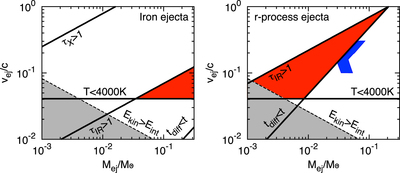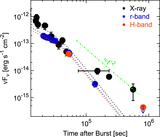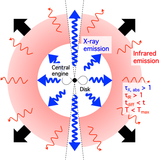Image Details
Caption: Figure 3.
Allowed parameter space to reproduce the infrared excess by reprocessing the X-ray excess emission in GRB 130603B. The left panel shows the iron ejecta case. A reasonable range of the parameters, the ejecta mass ﹩{M}_{{\rm{ej}}}\gtrsim 0.04{M}_{\odot }﹩ and velocity ﹩{v}_{{\rm{ej}}}/c\gtrsim 0.04﹩, satisfies our model criteria. The condition ﹩{{ \mathcal R }}_{{\rm{rec}}}\gt {{ \mathcal R }}_{{\rm{ion}}}﹩ is satisfied in the displayed area with ﹩h{\nu }_{{\rm{i}}}=10\;{\rm{keV}}﹩ and ﹩\epsilon {L}_{{\rm{X}}}\sim {10}^{41}﹩ erg s−1, so ﹩{f}_{{\rm{n}}}=1﹩ is a good approximation (Equation (9)). The kinetic energy is larger than the internal energy above the gray region (the boundary (the dashed line) is described by Equation (20)), which is the physical situation. The right panel shows the r-process ejecta case. The ejecta mass ﹩{M}_{{\rm{ej}}}\sim {10}^{-3}\mbox{--}{10}^{-2}{M}_{\odot }﹩ and velocity ﹩{v}_{{\rm{ej}}}/c\sim 0.04\mbox{--}0.2﹩ satisfy our model criteria. For comparison, we also plot the parameter region of the r-process heating model in Berger et al. (2013) as a blue region.
Copyright and Terms & Conditions
© 2016. The American Astronomical Society. All rights reserved.






